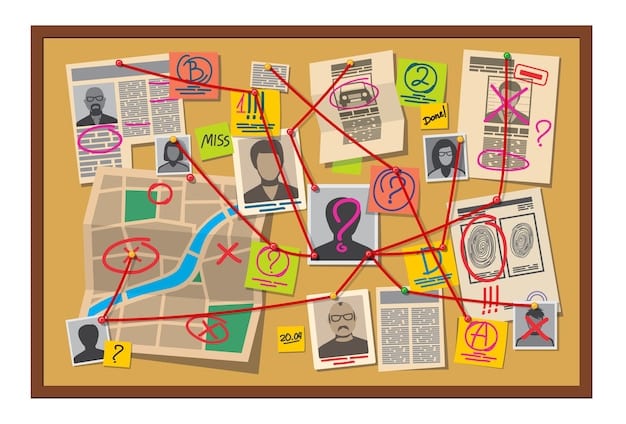Deepfakes and Disinformation: Your Guide to Spotting Fake News Online

Navigating the digital age requires vigilance; this guide equips you with the knowledge to identify deepfakes and disinformation, empowering you to protect yourself against online deception.
In today’s hyper-connected world, discerning truth from fiction online is more challenging than ever. Deepfakes and Disinformation: How to Spot Fake News and Protect Yourself Online is a crucial skill for navigating the digital landscape.
Understanding the Deepfake Phenomenon
Deepfakes, a portmanteau of “deep learning” and “fake,” represent a significant evolution in online disinformation. They leverage artificial intelligence to create highly realistic, yet entirely fabricated, videos and audio recordings.
These sophisticated manipulations present a unique challenge to critical thinking and media literacy. They can erode trust in institutions and individuals alike.
How Deepfakes are Created
The creation of deepfakes relies on advanced machine learning algorithms. These algorithms analyze vast amounts of existing data to learn the nuances of a person’s appearance, voice, and mannerisms.
This learning process allows the AI to convincingly map these characteristics onto another person’s face or body, or to create entirely new content from scratch.
The Potential Impact of Deepfakes
The potential consequences of widespread deepfakes are far-reaching and concerning. They can be used to spread misinformation, damage reputations, and even incite violence.
- Erosion of Trust: Deepfakes can undermine trust in legitimate news sources and institutions.
- Political Manipulation: They can be used to influence elections and political discourse.
- Personal Attacks: Individuals can be targeted with fabricated content designed to cause harm.
- Financial Scams: Deepfakes can be used to impersonate individuals for financial gain.
Deepfakes are not just a technological curiosity; they represent a serious threat to the integrity of information and the stability of society.

Identifying Deepfake Videos: Key Indicators
While deepfake technology is constantly evolving, there are still telltale signs that can help you identify manipulated videos. Paying close attention to these indicators can help you differentiate between authentic and fabricated content.
Keep in mind that even subtle anomalies can be a red flag, and it’s always best to err on the side of caution when evaluating online videos.
Visual Inconsistencies
- Unnatural Blinking: Deepfakes often struggle to replicate natural blinking patterns. Look for excessive blinking, a lack of blinking, or inconsistent blinking.
- Lip Sync Issues: Discrepancies between lip movements and audio can indicate manipulation. Pay attention to whether the words match the mouth movements precisely.
- Lighting and Skin Tone: Inconsistencies in lighting or skin tone can be a sign of a deepfake. Look for unnatural shadows or color variations.
- Blurry Regions: Deepfakes may have blurry or distorted regions around the face or other key areas.
Audio Anomalies
While visual cues are often the primary focus of deepfake detection, audio analysis can also reveal signs of manipulation. Subtle variations in tone, pitch, and background noise can be telltale indicators.
Analyzing the audio alongside the visual elements can provide a more comprehensive assessment of a video’s authenticity.
Contextual Clues
Sometimes, the context surrounding a video can provide clues about its authenticity. Consider the source of the video, the channel it was published on, and the overall narrative being presented.
Whether the source is trustworthy and credible should be considered. It is important to ask yourself if the narrative matches your prior knowledge.
By paying attention to these visual, auditory, and contextual clues, you can significantly increase your chances of identifying deepfake videos.
Deciphering Disinformation Tactics Online
Disinformation takes many forms, from outright lies to subtle distortions of the truth. Understanding the various tactics used to spread disinformation is crucial for navigating the online world.
Recognizing these tactics allows you to critically evaluate information and avoid being misled by false narratives.
Common Disinformation Techniques
- False Context: Presenting accurate information in a misleading context to create a false impression.
- Impersonation: Creating fake accounts or websites that mimic legitimate sources.
- Emotional Manipulation: Using emotionally charged language or imagery to manipulate opinions.
- Conspiracy Theories: Promoting unsubstantiated theories that appeal to distrust and paranoia.
Identifying Bots and Trolls
Bots and trolls play a significant role in spreading disinformation online. Bots are automated accounts that can amplify messages and create the illusion of widespread support.
Trolls, on the other hand, are individuals who intentionally disrupt online discussions and spread inflammatory content.
The Role of Social Media Algorithms
Social media algorithms can inadvertently contribute to the spread of disinformation. These algorithms often prioritize engagement over accuracy, which can lead to the amplification of sensational or misleading content.
Social media algorithms often create “echo chambers” that expose users only to information confirming their existing beliefs.
These echo chambers can lead to polarization and make it even more difficult to discern the truth.
By understanding how these algorithms work, you can take steps to mitigate their impact on your information consumption.

Protecting Yourself from Online Disinformation
Protecting yourself from online disinformation requires a multi-faceted approach that combines critical thinking, media literacy, and proactive online habits.
By taking these steps, you can minimize your exposure to false information and contribute to a more informed online environment.
Cultivate Critical Thinking Skills
Critical thinking is the foundation of disinformation defense. It involves questioning assumptions, evaluating evidence, and considering alternative perspectives.
By developing your critical thinking skills, you can become a more discerning consumer of online information.
Verify Information with Multiple Sources
Never rely on a single source of information. Cross-reference information with multiple reputable sources to ensure accuracy and completeness.
Utilizing fact-checking websites can add an important layer of safety.
Checking a news or media source’s reliability should be automatic.
Be Wary of Emotional Content
Disinformation often relies on emotional manipulation. Be wary of content that evokes strong emotions, such as anger, fear, or outrage.
Evaluate the information objectively, even if it aligns with your existing beliefs.
Staying informed about current events and being aware of common disinformation tactics are crucial steps in protecting yourself from online manipulation.
Tools and Resources for Identifying Fake News
A variety of tools and resources are available to help you identify fake news and disinformation. These resources can provide valuable assistance in evaluating online content and verifying its accuracy.
Leveraging these tools can empower you to become a more informed and responsible consumer of online information.
Fact-Checking Websites
Fact-checking websites like Snopes and PolitiFact are dedicated to debunking false claims and verifying the accuracy of news stories.
These websites employ professional journalists and researchers who meticulously investigate claims and provide evidence-based assessments.
Reverse Image Search
Reverse image search tools like Google Images and TinEye allow you to trace the origin of an image and identify if it has been manipulated or used in a misleading context.
These tools can be particularly useful for identifying deepfakes and other forms of visual disinformation.
Browser Extensions
Various browser extensions are available that can help you identify fake news and disinformation while you browse the web. Such as: NewsGuard, and Fakespot
These extensions provide real-time warnings about potentially unreliable sources and can help you make more informed decisions about the content you consume.
By utilizing these tools and resources, you can equip yourself with the skills and knowledge necessary to navigate the online world safely and responsibly.
The Fight Against Disinformation: A Collective Responsibility
Combating disinformation requires a collective effort from individuals, institutions, and technology companies. It is a shared responsibility to promote media literacy, critical thinking, and responsible online behavior.
By working together, we can create a more informed and resilient information ecosystem.
The Role of Social Media Platforms
Social media platforms have a crucial role to play in combating disinformation. They must invest in technologies and policies that identify and remove false content from their platforms.
They must also be transparent about their algorithms and how they impact the spread of information.
Educating the Public
Education is key to combating disinformation. Schools, libraries, and community organizations should provide media literacy training to help people develop critical thinking skills and identify false information.
It’s also important to educate people about the dangers of disinformation and how it can impact their lives.
Supporting Independent Journalism
Independent journalism plays a vital role in holding power accountable and providing accurate information to the public. Supporting independent news organizations and journalists is crucial for combating disinformation.
By supporting journalists, one also supports well-researched, verifiable news.
By working together, we can create a more informed and resilient information ecosystem, where truth prevails over falsehood.
| Key Point | Brief Description |
|---|---|
| 🧐 Identify Deepfakes | Look for visual and audio inconsistencies like unnatural blinking, lip sync issues, or blurry regions. |
| 📢 Disinformation Tactics | Recognize techniques like false context, impersonation, and emotional manipulation. |
| 🛡️ Protect Yourself | Cultivate critical thinking, verify information with multiple sources, and be wary of emotional content. |
| 🌐 Use Fact-Checking Tools | Utilize fact-checking websites, reverse image search, and browser extensions to verify information. |
FAQ
▼
A deepfake is a manipulated video or audio recording created using artificial intelligence. It can convincingly depict someone saying or doing something they never did.
▼
Look for visual inconsistencies like unnatural blinking or blurry regions. Also, listen for audio anomalies and check the video source.
▼
Common tactics include using false context, impersonating legitimate sources, and employing emotional manipulation to sway opinions.
▼
Develop critical thinking skills, verify information with multiple sources, and be cautious of content that evokes strong emotions to manipulate you.
▼
Fact-checking websites, reverse image search tools, and browser extensions can help you verify the accuracy and origin of online information.
Conclusion
In an era defined by digital deception, empowering ourselves with the knowledge and tools to identify and combat deepfakes and disinformation is not just a personal safeguard, but a civic duty. By cultivating critical thinking skills, utilizing fact-checking resources, and fostering a culture of media literacy, we can collectively navigate the complexities of the online world and protect the integrity of information for a more informed and truthful society.






